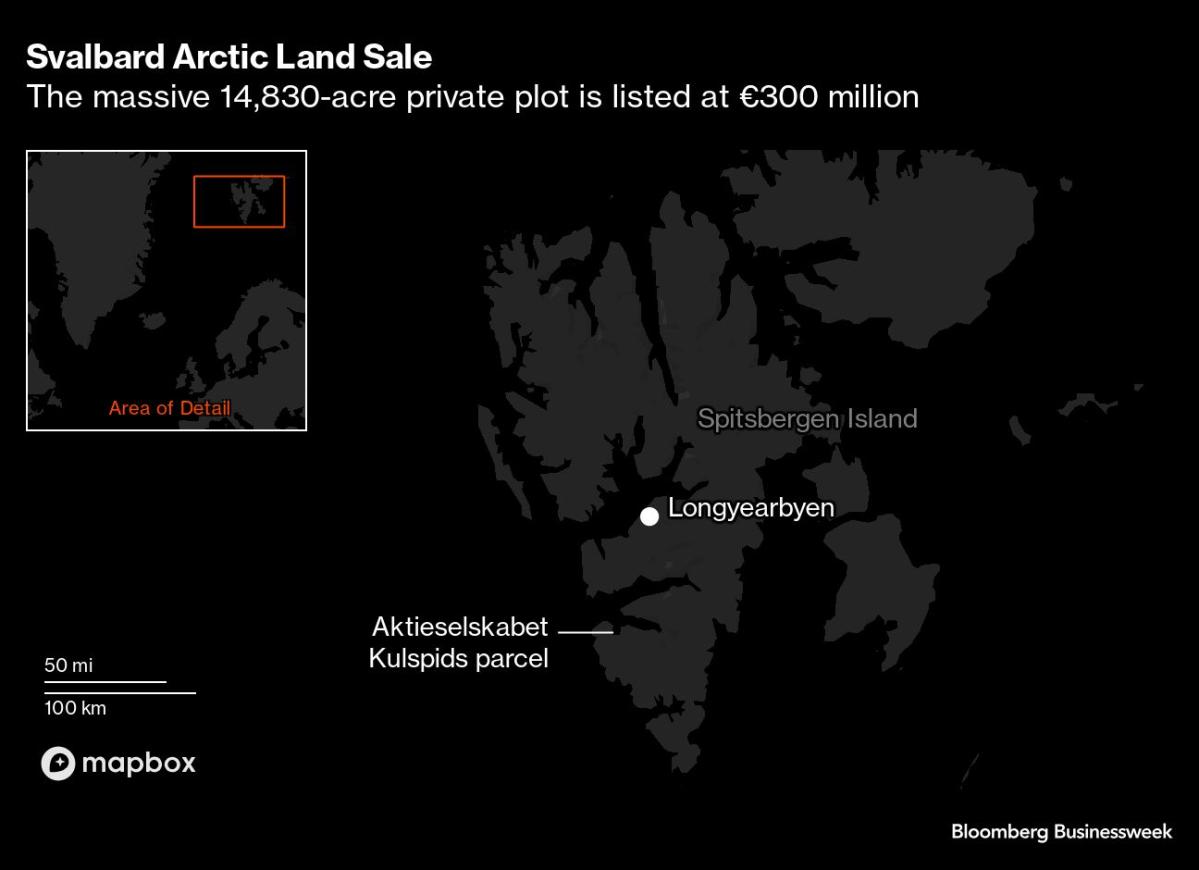(Bloomberg) — In the High Arctic, a Manhattan-size piece of land with geopolitical implications has hit the market for €300 million ($323 million).
Most Read from Bloomberg
The sale comes as the Arctic experienced its warmest summer in 2023, and the Svalbard region has had less sea ice, more rain and higher temperatures because of climate change. The sea-ice loss is a boon to Russia, which has been gaining access to additional shipping routes and energy reserves as the territory opens up.
“This is the only possibility for a buyer to get a position in the High Arctic and establish a strategic foothold,” says Per Kyllingstad, a lawyer representing the sellers, speaking exclusively to Bloomberg News via Zoom from Oslo. He says it’s the last privately held plot in the nine-island Norwegian archipelago.
Svalbard is one of the northernmost settlements in the world. It’s east of Greenland, about halfway between the Scandinavian mainland and the North Pole. Approximately 60% of it is covered with glaciers, and it’s home to polar bears and arctic foxes. It’s become a destination for adventure-seeking travelers and for scientists securing the survival of the human race. (The famous “Doomsday” Vault of seeds is buried here.)
The private plot is being marketed by Knight Frank LLP globally. Norway and Russia state-owned companies own the other land in Svalbard.
Controversy erupted in 2014 when another privately owned property in the region went up for sale. When it was reported that a Chinese buyer was interested in coal mining land, people worried that the parcel would fall into foreign hands. Two years later the Norwegian state bought it instead.
“We have offered the property to noncontroversial buyers. No conclusion was reached,” says Kyllingstad, who says they were in discussions with the Norwegian government about a sale. “Now we are offering the same to all buyers, controversial or not. The sellers will sell to the highest bidder,” he says. A representative from the Norwegian government has not responded to a request for comment.
The 14,830-acre plot lies approximately 40 miles away from the inhabited town of Longyearbyen (pop: 2,400) on the island of Spitsbergen. It includes more than 3 miles of coastline and is full of mountains, fjords and Arctic wildlife. From April to August, it’s under constant sunshine; October to February is the dark season.
The remote plot has been owned for more than a century by Norwegian holding company Aktieselskabet Kulspids. The company was founded by wealthy families from Oslo who were interested in the area for its natural resources—they wanted to mine for asbestos—but shares have changed hands over the past hundred years. The names of shareholders are not being disclosed, though they’re all Norwegian, Kyllingstad says.
“There has been a great interest in the Arctic during the last few years, and that has to do with climate change, because it is opening up possibilities that we have not seen before,” he continues.
The Arctic holds an estimated 13% of the world’s undiscovered oil resources, according to research from the US Geological Survey. Kyllingstad says the only geographic survey done was originally for asbestos (none was found), and they have no knowledge of other resources on this land.
The UK had looked into buying a different area on the Svalbard archipelago to increase its post-Brexit fishing waters in 2017, with the former foreign minister Tobias Ellwood saying that Svalbard offered a “serious bit of real estate.”
Knight Frank says this massive tract of land could be an investment project for a high-net-worth individual looking to make a big impact as an environmentalist who would conserve it. The Arctic is vitally important in the fight against climate change. The waters around the Arctic help regulate ocean currents, moving cold and warmer waters around the planet. Essentially, the Arctic helps cool the planet.
“This is a genuine opportunity for a very rich private individual to make a difference,” says Will Matthews, who is leading the listing at Knight Frank. Matthews says he’s noticed a trend of nature restoration purchases in the UK, where he’s based. Last year, for instance, a wildlife trust bought 18,500 acres for a conservation project in the Scottish Highlands.
Building another another tourist village is also a possibility because polar tourism has taken off in recent years (though not without its hiccups).
There’s only one major restriction to the use of the land. Buyers—be they a foreign state, corporations or individuals—have to be bound to the terms of the 1920 Svalbard Treaty, which recognizes the sovereignty of Norway and forbids military use for “war-like purposes.” This treaty was signed after the negotiations in Versailles that ended World War I. More than 40 countries, including China, Russia, the UK and the US, have signed it.
Kyllingstad says the sale is a “fairly sensitive transaction due to geopolitical considerations,” but that because of the treaty, the buyers can do what they like with the purchase within the guidelines.
“It’s truly the last chance to acquire property in the High Arctic,” he says.
Most Read from Bloomberg Businessweek
©2024 Bloomberg L.P.


